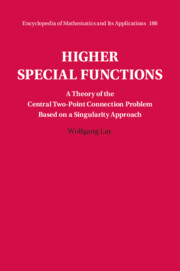 Higher Special Functions
Higher Special Functions Published online by Cambridge University Press: 16 May 2024
Global properties now come into play. To distinguish Frobenius and Thomé solutions, we consider regular and irregular singularities of differential equations and hence Fuchsian differential equations and their confluent cases. The simplest singularity of a differential equation is a pole of at most first order in the coefficient before the first derivative and a pole of at most second order in the coefficient before the zeroth derivative. Such a singularity is called regular, otherwise it is irregular. A Fuchsian differential equation only has regular singularities; with irregular singularities it is a confluent case. We also need to consider the so-called form of a differential equation. A Fuchsian differential equation with one singularity is Laplace; two singularities is Euler; three singularities is Gauss; four singularities is Heun. While singular boundary eigenvalue problems of the Gauss differential equation and its confluent cases produce classical special functions, for the Heun differential equation and its confluent cases they produce higher special functions.
To save this book to your Kindle, first ensure [email protected] is added to your Approved Personal Document E-mail List under your Personal Document Settings on the Manage Your Content and Devices page of your Amazon account. Then enter the ‘name’ part of your Kindle email address below. Find out more about saving to your Kindle.
Note you can select to save to either the @free.kindle.com or @kindle.com variations. ‘@free.kindle.com’ emails are free but can only be saved to your device when it is connected to wi-fi. ‘@kindle.com’ emails can be delivered even when you are not connected to wi-fi, but note that service fees apply.
Find out more about the Kindle Personal Document Service.
To save content items to your account, please confirm that you agree to abide by our usage policies. If this is the first time you use this feature, you will be asked to authorise Cambridge Core to connect with your account. Find out more about saving content to Dropbox.
To save content items to your account, please confirm that you agree to abide by our usage policies. If this is the first time you use this feature, you will be asked to authorise Cambridge Core to connect with your account. Find out more about saving content to Google Drive.